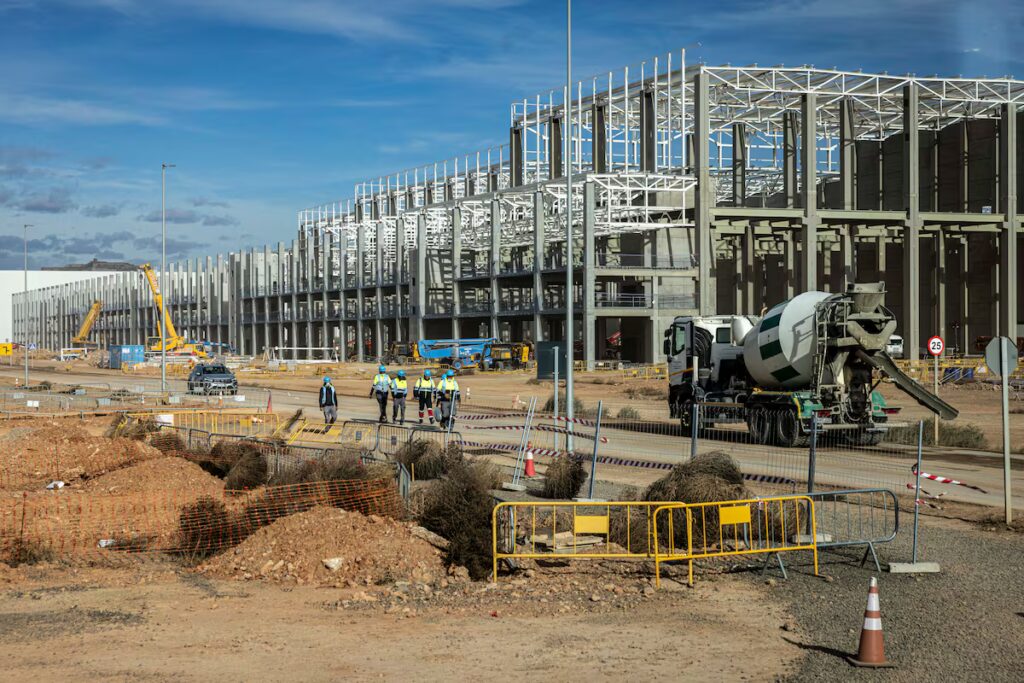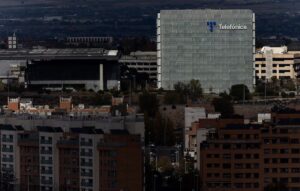
Just three and a half years ago, the then CEO of the Volkswagen Group, Herbert Diess, announced with great fanfare the largest industrial investment in the history of Spain. This was 10,000 million euros that the company would mobilize together with its “Future Fast: Forward” partners, which would be used to electrify the Spanish automotive industry with a flagship project: a battery plant that would be built in Sagunto. The event, held in May 2022, in the presence of the president of the government, Pedro Sánchez, took place in a roundabout surrounded by orange trees.
That bucolic scene has now been replaced by a very different one, in which giant, half-finished white structures stand around train tracks that didn’t exist before. Around it, hundreds of workers and excavators are trying to prepare everything so that in September next year the first batteries will be released that will power the electric vehicles that the Volkswagen group will begin assembling in 2027 in Martorell (Barcelona) and Landaben (Navarre).
“Just a year ago we erected the first pillar,” Javier Rivera, financial director of PowerCo (the Volkswagen subsidiary responsible for the battery business) in Spain, proudly tells a group of journalists during a guided tour of the plant. “We maintain our forecast to start production in September 2026 in this first block and will achieve a stable production rate throughout 2027,” he explains.
The block he refers to is capable of producing, when at its maximum activity, around 10 GWh per year, which translates into around 55,000 cells per day. If each electric car requires between 100 and 120 cells, that means that block alone will produce enough batteries for between 450 and 550 electric cars per day. Before Christmas the company plans to finish the civil works (i.e. the actual structure) of the first block. The plan is to operate three shifts every day of the week. In total, the project is made up of four blocks that will total 40 GWh, but PowerCo has enough space to reach 60 GWh, although this will depend on the demand it receives from the German consortium itself.
When the four blocks are completed, cells will be built for around half a million electric vehicles per year, representing almost a quarter of total car production in Spain. The second 10 GWh block will begin production in the first half of 2027 and conclude phase I of the project, with which the company hopes to employ 1,600 people. When Phase II is completed, expected no earlier than 2028, and reaches full capacity, PowerCo will employ more than 3,000 people in Sagunto.
The white rooms
Upon entering these buildings you notice that they are still empty shells, since the machinery that will be needed to build the cells has not yet arrived. Machines that will arrive, for the most part, from China, and which will have to work in very rigid dry conditions, without dust – a great challenge given the surroundings, where it is normal for the wind to blow strongly – and at a stable temperature of around 21 degrees, even if slight variations may be allowed in this last aspect. These are the so-called white and dry rooms, which have a height of 24 meters and for the construction of which PowerCo relied on the South Korean company K-Ensol. In total there will be 17 rooms in each block, which will take up the equivalent of eight football pitches.
“To give us an idea, in Sagunto we have an average humidity above 60%, which on rainy days reaches up to 94%. Here we have to reduce it to less than 1%, which we will do with huge 30-ton equipment. As for dust, the size of the particles that can enter the room will be 140 times smaller than a person’s hair,” says Javier Duart, responsible for the design and execution of the clean rooms.
Currently around 1,400 people work on this land, of which around 300 are from PowerCo, while the rest are construction workers. Next year, the Volkswagen Group plans to hire around 500 plant operators to start operating a gigafactory from which all the batteries will be sent by train to Martorell and Landaben. These factories will next year produce the Volkswagen Group’s four most affordable electric models to date, all with entry-level versions around or below 25,000 euros. These are the Cupra Raval, the Volkswagen ID. Polo, Volkswagen ID. Cross and Skoda Epiq. However, Rivera, responding to a question from this medium, specified that PowerCo Spain is willing to supply other automotive plants of the group, such as the Portuguese one, which produces Volkswagen’s electric car for less than 20,000 euros and which will arrive in 2027.
Regarding Sagunto’s battery cell technology, production will initially be LFP (lithium ferrophosphate) batteries. These are the same type of batteries that will be made by the gigafactory that Stellantis will build in Zaragoza with the help of its Chinese partner CATL, the largest battery manufacturer in the world, which will require an investment of 4.1 billion, compared to the 3.0 billion that Volkswagen initially allocates in Sagunto. This technology has the advantage of being cheaper than NMC, even if it has a lower energy density. This means that it is mainly used in small electric cars with a more urban character. However, Rivera says the Sagunto plant will be “flexible” and can adapt its production to other technologies, such as sodium cells or solid-state batteries. The latter is a technological bet for the future of the automobile, even if it has yet to become a reality on the market.





